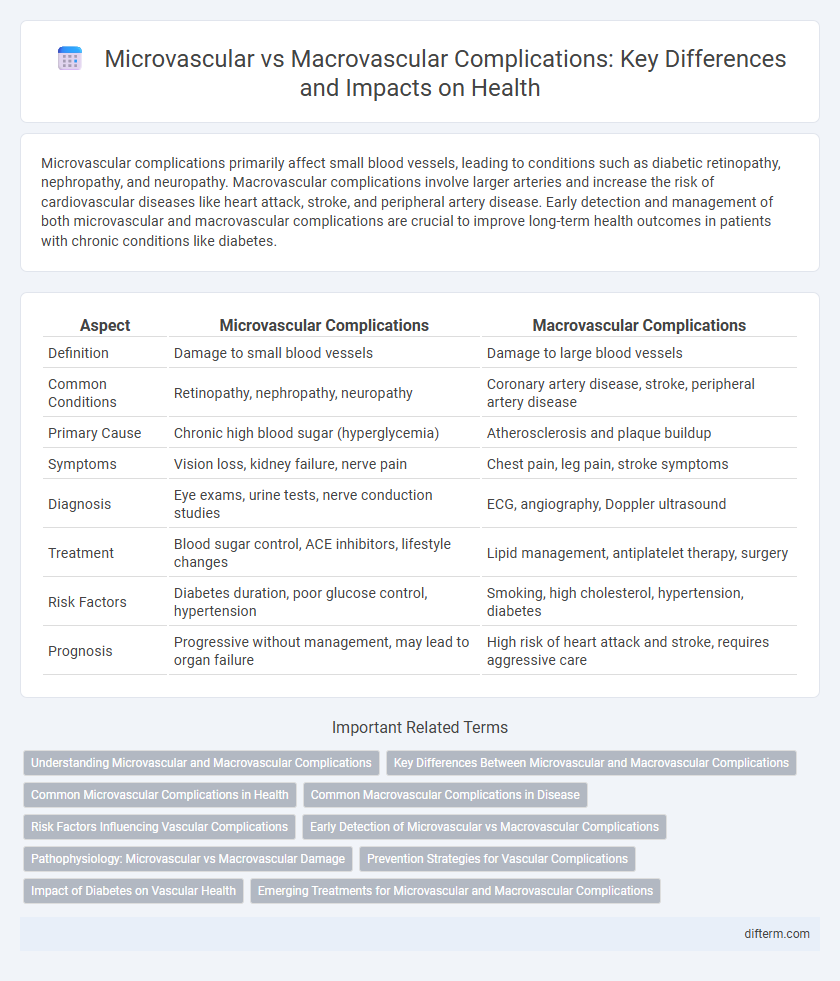Microvascular complications primarily affect small blood vessels, leading to conditions such as diabetic retinopathy, nephropathy, and neuropathy. Macrovascular complications involve larger arteries and increase the risk of cardiovascular diseases like heart attack, stroke, and peripheral artery disease. Early detection and management of both microvascular and macrovascular complications are crucial to improve long-term health outcomes in patients with chronic conditions like diabetes.
Table of Comparison
| Aspect | Microvascular Complications | Macrovascular Complications |
|---|---|---|
| Definition | Damage to small blood vessels | Damage to large blood vessels |
| Common Conditions | Retinopathy, nephropathy, neuropathy | Coronary artery disease, stroke, peripheral artery disease |
| Primary Cause | Chronic high blood sugar (hyperglycemia) | Atherosclerosis and plaque buildup |
| Symptoms | Vision loss, kidney failure, nerve pain | Chest pain, leg pain, stroke symptoms |
| Diagnosis | Eye exams, urine tests, nerve conduction studies | ECG, angiography, Doppler ultrasound |
| Treatment | Blood sugar control, ACE inhibitors, lifestyle changes | Lipid management, antiplatelet therapy, surgery |
| Risk Factors | Diabetes duration, poor glucose control, hypertension | Smoking, high cholesterol, hypertension, diabetes |
| Prognosis | Progressive without management, may lead to organ failure | High risk of heart attack and stroke, requires aggressive care |
Understanding Microvascular and Macrovascular Complications
Microvascular complications in health primarily affect small blood vessels, leading to conditions such as diabetic retinopathy, nephropathy, and neuropathy, which impair vision, kidney function, and nerve health. Macrovascular complications involve large blood vessels and are responsible for cardiovascular diseases like coronary artery disease, stroke, and peripheral artery disease, significantly increasing morbidity and mortality in diabetic patients. Understanding these distinct vascular complications helps in tailoring preventive strategies and optimizing treatment to reduce long-term health risks.
Key Differences Between Microvascular and Macrovascular Complications
Microvascular complications primarily affect small blood vessels, leading to conditions such as retinopathy, nephropathy, and neuropathy, which are common in diabetes. Macrovascular complications involve larger arteries and contribute to cardiovascular diseases like coronary artery disease, stroke, and peripheral artery disease. The key differences lie in the vessel size affected and the resultant clinical outcomes, with microvascular damage causing organ-specific dysfunction and macrovascular damage increasing the risk of systemic cardiovascular events.
Common Microvascular Complications in Health
Common microvascular complications in health primarily include diabetic retinopathy, nephropathy, and neuropathy, which result from damage to small blood vessels. These complications frequently occur in individuals with chronic conditions such as diabetes mellitus, leading to vision loss, kidney failure, and nerve dysfunction. Early detection through regular screening and tight glycemic control significantly reduces the risk and progression of these microvascular disorders.
Common Macrovascular Complications in Disease
Common macrovascular complications in disease primarily involve large blood vessels, including coronary artery disease, cerebrovascular disease, and peripheral arterial disease. These conditions contribute significantly to morbidity and mortality in patients with diabetes and hypertension by causing heart attacks, strokes, and limb ischemia. Effective management of risk factors such as hyperglycemia, hypertension, and dyslipidemia is critical to preventing the progression of macrovascular complications.
Risk Factors Influencing Vascular Complications
Risk factors influencing microvascular complications, such as retinopathy, nephropathy, and neuropathy, primarily include chronic hyperglycemia, hypertension, and duration of diabetes. Macrovascular complications, involving coronary artery disease, stroke, and peripheral artery disease, are strongly associated with factors like dyslipidemia, smoking, hypertension, and insulin resistance. Both types of complications share overlapping risks but differ in pathophysiology and targeted preventive strategies.
Early Detection of Microvascular vs Macrovascular Complications
Early detection of microvascular complications, such as retinopathy, nephropathy, and neuropathy, relies on regular screening tests like fundus examinations, microalbuminuria assessments, and nerve conduction studies, which allow timely intervention to prevent progression. Macrovascular complications, including coronary artery disease, stroke, and peripheral artery disease, require monitoring of risk factors through lipid profiles, blood pressure checks, and imaging modalities like carotid ultrasound and coronary calcium scoring. Emphasizing targeted screening strategies for microvascular and macrovascular complications in high-risk individuals enhances prognosis and reduces long-term morbidity in chronic conditions like diabetes mellitus.
Pathophysiology: Microvascular vs Macrovascular Damage
Microvascular complications primarily result from chronic hyperglycemia-induced damage to small blood vessels, leading to basement membrane thickening, endothelial dysfunction, and capillary occlusion in organs like the eyes, kidneys, and nerves. Macrovascular complications involve atherosclerosis characterized by lipid accumulation, inflammation, and plaque formation in large arteries, increasing the risk of coronary artery disease, stroke, and peripheral artery disease. The distinct pathophysiological mechanisms driving microvascular and macrovascular damage underscore the importance of tailored therapeutic strategies targeting endothelial injury and metabolic disturbances.
Prevention Strategies for Vascular Complications
Effective prevention strategies for microvascular complications focus on tight glycemic control, regular monitoring of blood glucose levels, and maintaining blood pressure within recommended targets to reduce risks of neuropathy, nephropathy, and retinopathy. Macrovascular complication prevention emphasizes lipid management, smoking cessation, and promotion of physical activity to lower the incidence of cardiovascular events like myocardial infarction and stroke. Integrating multidisciplinary care approaches and patient education enhances adherence to lifestyle modifications and pharmacological treatments, improving overall vascular health outcomes.
Impact of Diabetes on Vascular Health
Diabetes significantly affects vascular health by accelerating the onset of both microvascular complications, such as retinopathy, nephropathy, and neuropathy, and macrovascular complications, including coronary artery disease, stroke, and peripheral arterial disease. Chronic hyperglycemia induces endothelial dysfunction and inflammation, leading to damage in small blood vessels and large arteries alike. Effective glycemic control and early intervention are critical to reducing the risk of these diabetes-related vascular complications and improving long-term patient outcomes.
Emerging Treatments for Microvascular and Macrovascular Complications
Emerging treatments for microvascular complications, such as diabetic retinopathy and nephropathy, include advanced anti-VEGF therapies and novel SGLT2 inhibitors, which target endothelial dysfunction and reduce inflammation. For macrovascular complications like atherosclerosis and peripheral artery disease, innovative approaches involve PCSK9 inhibitors and RNA-based therapeutics that improve lipid profiles and stabilize plaques. Research continues to emphasize precision medicine and molecular targeting to enhance efficacy and minimize adverse effects in both microvascular and macrovascular disease management.
Microvascular Complications vs Macrovascular Complications Infographic

 difterm.com
difterm.com